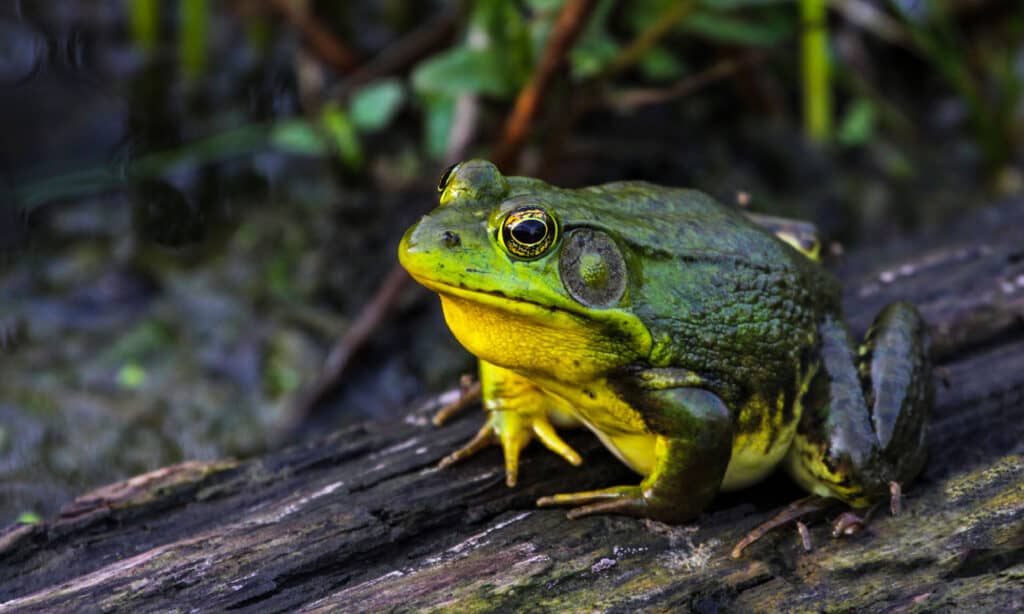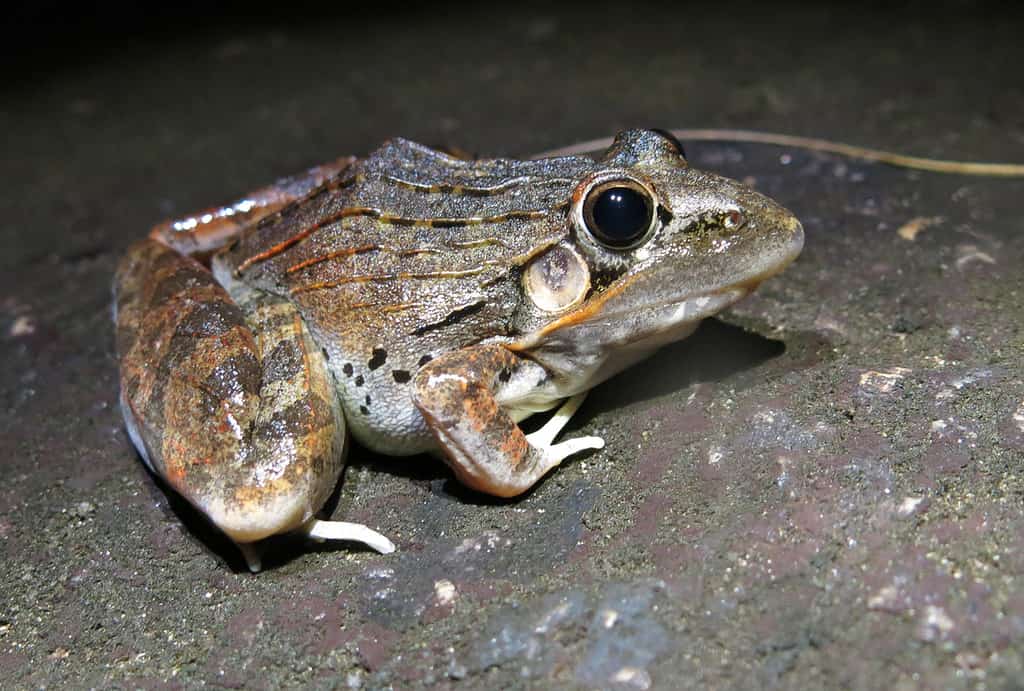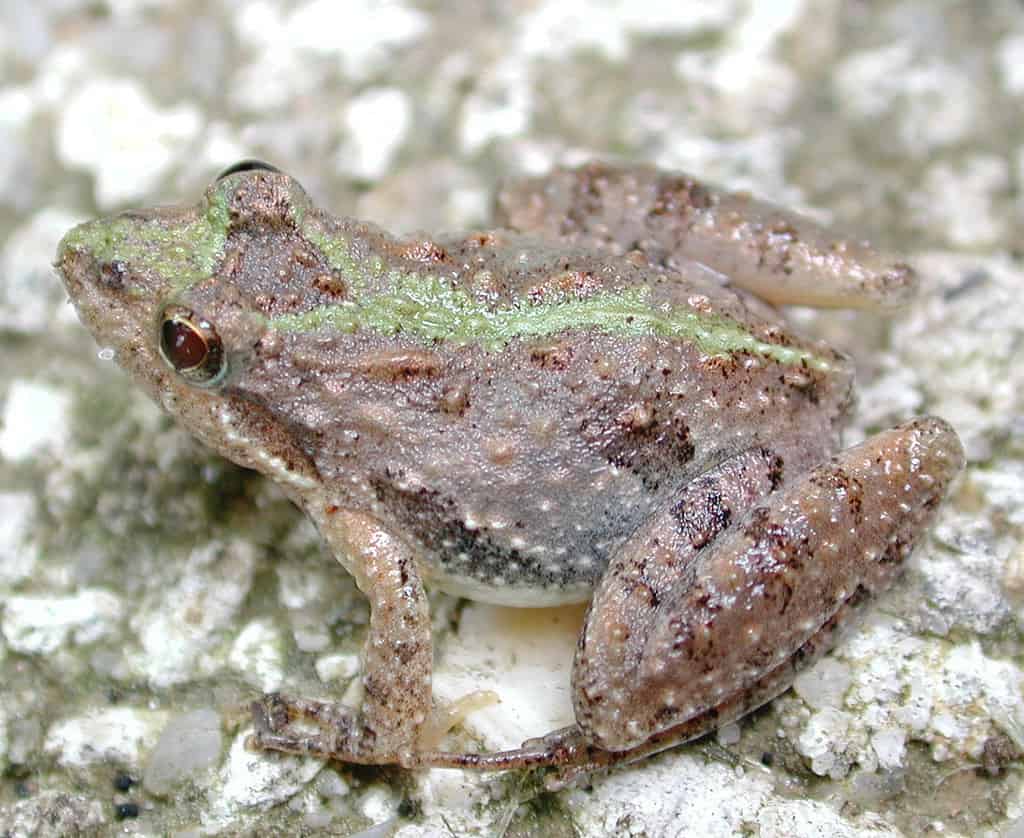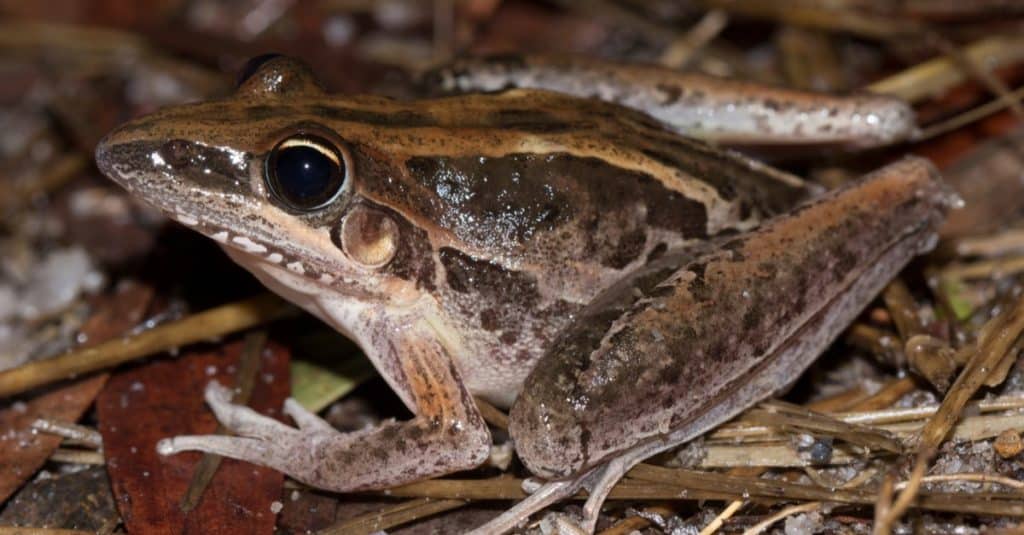One of the most commonplace questions regarding these amphibians is, how high can frogs jump? The answer to this question depends on many factors, like the species, the size, and more. For example, the South African sharp-nosed frog can jump 95 times its body length and holds the World Record for jumping an incredible 17.6 feet high. Interestingly, if humans could do the same thing, they could jump 517 feet, almost one and a half football fields. However, other species, like the American bullfrog, can jump seven feet. Therefore, this article will cover four frog species known for how high they can jump.
Average Height Frogs Can Jump By Species
The table below shows the most impressive jumps recorded by frogs.
| Species | Average Jump |
|---|---|
| South African Sharp-Nosed Frog | 17.6 feet |
| Striped Rocket Frog | 9.2 feet |
| American Bullfrog | 7.16 feet |
| Southern Cricket Frog | 6.4 feet |
What the Research Tells Us
The research tells us that the larger the frog, the farther it can jump. However, it is a generalization and is not true for all species. Furthermore, some frogs change the distance of every jump. This is assumed to be an energy-saving behavior. Also, small frogs have the strongest jumping power in relation to their body size. For example, the Southern Cricket frog can jump 62 times its body length, approximately 6.4 feet, since they measure an average of 1.25 inches. Compare this to the American Bullfrog, which can grow up to 8 inches in length and jump 7.4 feet which is 11 times its body length.
Another generalization is that female frogs can jump farther than male frogs, as they are normally bigger. However, this might be true for some species but not others. Also, the bigger a frog’s body mass, the less jumping power it has. For better clarification, one needs to look at each species as their jumping heights vary. Therefore, below is a detailed description of the frogs mentioned in the table above.
American Bullfrog
These bullfrogs are amphibians, which are cold-blooded and have soft, moist skin. In addition, they lay eggs without shells and start as larvae before they develop into frogs. American bullfrogs are carnivores and eat water beetles, snails, crayfish, small fish, dragonfly nymphs, and even small birds. However, raccoons, foxes, herons, and snapping turtles eat or prey on them. They are brown and green and very well camouflaged between the plants around ponds. Bullfrogs are the biggest frogs found in the United States. Male American bullfrogs have yellow throats, while females have white throats. Also, these frogs can grow up to 8 inches and weigh over 1 pound.
Their life cycle starts as eggs laid in a jelly-like mass that floats on the top of the water. One frog can lay between 12,000 and 20,000 eggs at a time. These eggs spend about two winters as tadpoles and then live up to 8 years. Interestingly, frogs cannot turn their heads. Therefore, they have big bulging eyes that sit on the top of their skulls, giving them a wider view. Most frogs croak by inhaling and then closing their nostrils, forcing air backward and forwards between their vocal sack and lungs. Only male bullfrogs croak, and they do this to establish territory and attract mates. Lastly, frogs do not have diaphragms, so they use their throats to push air in and out of their lungs. Also, they can absorb air through their skin directly into their blood vessels. However, their skin needs to be wet to do this, which is why they secrete mucous.

The average American bullfrog can jump over 7 feet.
©iStock.com/187715314
South African Sharp-Nosed Frog
The South African sharp-nosed frog occurs in many places on the African continent, including:
- Senegal
- Angola
- Namibia
- Botswana
- Zimbabwe
- Mozambique
- South Africa (Limpopo, Mpumalanga, KwaZulu-Natal, Swaziland, and the Eastern Cape)
This frog prefers to breed in moist, open savanna and woodland areas. They are part of the Ptychadena species and can survive in dry conditions. In the summer, they can forage far from their breeding sites. Also, when they are threatened, they make use of their extraordinary ability to leap far distances. They breed from October to January in the province of KwaZulu-Natal in South Africa. Males will call from their breeding sites at night; most breeding occurs within 48 hours of rain. The females will lay their eggs in shallow water. The fertilization process is quite fascinating. Females will raise their cloacas out of the water and release the eggs. Then, males will release their sperm directly onto the eggs using their feet to create a funnel. Therefore, fertilization occurs before the eggs reach the water. These newly laid eggs will float. However, they are easily disturbed and will eventually sink. After this, the tadpoles will hatch within two days, and metamorphosis is completed in eight weeks. The South African sharp-nosed frog has long legs and a pointed snout. Lastly, they eat things like arthropods and spiders.

The South African sharp-nosed prefers to breed in moist, open savanna and woodland areas.
Southern Cricket Frog
The southern cricket frog is the smallest frog found in Tennessee. These frogs have a dark triangle between their eyes and normally a bright Y stripe down their backs. They are different from the northern cricket frog because they have much shorter toes on their back webbed feet, a trait that can be seen without binoculars. Also, they have different vocalizations and ranges. These frogs use a call that sounds like two small rocks being knocked together and is louder than the northern cricket frog. However, their call maintains a regular tempo. Also, they can be heard from April to August.
They occur in southwest Tennessee and favor semi-permanent bodies of water, which include meadows, roadside ditches, creeks, and shallow ponds. They will eat insects like mosquitoes. Furthermore, females can lay up to 150 eggs at a time. She will do this by attaching the eggs to submerged vegetation or attaching them to the bottom of a shallow pool. After about 90 – 100 days, metamorphosis will take place. These frogs become sexually mature after about one year. You will find these frogs in Tennessee, but their numbers have declined since the 1970s. Lastly, the southern cricket frog is a much better jumper than the northern cricket frog and can jump up to eight feet.

The southern cricket frog is the smallest frog found in Tennessee.
Striped Rocket Frog
The striped rocket frog is known by a few different names, including the streamlined rocket frog, the rocket frog, and the Australian rocket frog. They occur on the island of New Guinea and in Australia. These frogs have long bodies and pointy noses, with some webbing on their feet. They also have black markings and stripes on their bodies, with ridges on their backs. Striped rocket frogs live on the ground of tropical forests and in ponds, streams, and swamps. They occur in the southern part of the island of New Guinea, in Indonesia, and Papua New Guinea.
Additionally, they inhabit Australia’s northern and eastern coasts and have even been spotted near Sydney. They have a reputation for being able to jump very far distances and can leap up to 12 feet. Furthermore, they have longer cartilage in their toes than most frogs, which is believed to be why they can jump so far.
The female striped rocket frog can lay between 50 -100 eggs at a time. They lay these eggs in bunches that float on the surface. Also, tadpoles can develop into frogs within six months. Striped rocket frogs are brown, yellow-brown-black, or reddish brown with distinctive dark stripes and markings down their bodies. In addition, their bellies are white, and the males have yellow throats. They have unwebbed front fingers and half-webbed toes. Lastly, they join many other species of rocket frogs in Australia but can be distinguished by the dark horizontal stripes down the side of their bodies.

The striped rocket frog is known by a few different names, including the streamlined rocket frog, the rocket frog, and the Australian rocket frog.
©Trevor Charles Graham/Shutterstock.com
The photo featured at the top of this post is © Christian Ouellet/Shutterstock.com
Thank you for reading! Have some feedback for us? Contact the AZ Animals editorial team.







